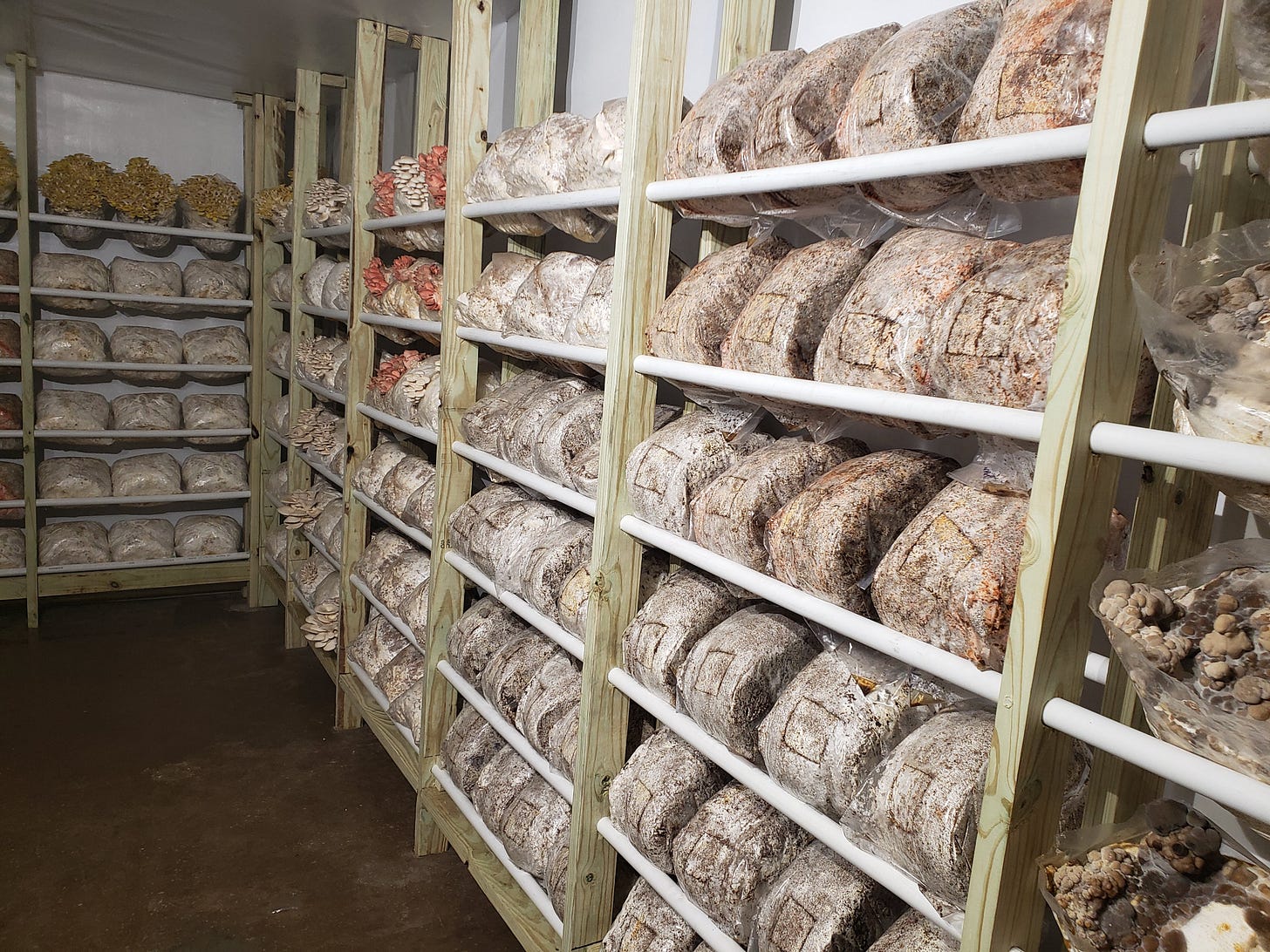The Challenge: We Can't Fund the Farms We Need
Expanding on the Roadmap to Scale Small Farms - Essay #3
This is the third essay in the Roadmap to Scale Small Farms series. If you missed the earlier pieces, the first focused on land access [HERE], and the second tackled farmer training [HERE]. Now we need to talk about what might be the biggest roadblock of all:
Funding.
If we want to build a real local food system—if we want to make farming a viable livelihood in cities like DFW—we need new financial models. Not someday. Now.
Starting a Farm Isn’t Just Noble. It’s Expensive.
Every business needs capital. Urban agriculture is no different. But for urban farmers, the costs hit early and hard:
Land (expensive and often contested in urban centers)
Infrastructure (greenhouses, irrigation, tools)
Compliance (zoning, permits, inspections)
Cold storage, wash/pack space, and delivery
When I co-founded my mushroom farm in 2019, we operated out of a 2,000 sqft warehouse. That’s less than 1/20th of an acre. But, we still had to pull together the equipment, systems, environmental controls, packaging tools, and more. The startup costs added up fast—and we hadn’t grown a single mushroom yet.
This isn’t unique to us. These are the realities for any aspiring urban farmer trying to build a system from scratch in an environment that wasn’t designed to support them.
When a Small Farm Isn’t Small Enough
Here’s one of the more frustrating disconnects: the USDA defines a "small farm" by income (<$250,000 in gross sales), but it still often associates that definition with land areas closer to 200 acres. Most urban farms are less than one acre.
Which means a farm growing food a few blocks from downtown might not qualify for:
Crop insurance
Traditional ag loans
State or federal grant programs
Urban farmers end up being too small, too diverse in crops, or too unconventional in structure to fit most of the current financial support systems.
Bootstrapping Isn’t a Strategy—It’s a Filter
Most urban farmers fund their operations through personal savings, part-time jobs, or community donations. That can work—but it often limits who can participate.
People with student debt. Single parents. Veterans. Anyone without a financial cushion.
That has real consequences. It filters out people with the skills, values, and drive who could contribute significantly to a better food system.
What We Actually Need: 5 Financial Solutions That Fit the Model
1. Local Microloans Tailored to Small Urban Farmers
Community banks and credit unions could be strong partners here. If structured well, microloans could cover things like:
Greenhouses and infrastructure
Hydroponic systems
Walk-in coolers or packing stations
Initial inventory or supply orders
A loan product that recognizes the scale and startup realities of urban agriculture could make a big difference—especially if paired with technical support.
2. Equipment Pools and Farm Incubator Tools
In the last essay, we talked about incubator farms. One way they could reduce financial barriers is by offering access to shared equipment:
Walk-behind tractors
Small trucks or trailers
Shared Cold storage units
Compost sifters or post-harvest stations
Instead of every farmer buying everything individually, shared ownership and cooperative use models could cut startup costs by 50% or more.
3. Urban Ag Co-ops and Food Aggregators
One of the most common financial constraints on new farmers is inconsistent sales. Food aggregators and cooperative sales programs could help stabilize revenue by:
Combining supply from multiple farms to minimize individual harvest variability
Handling restaurant deliveries and CSA fulfillment
Marketing under a single, recognizable local brand to promote market penetration
4. Easier Grant Access, Not Just More Grants
Even when grants are available, they can be hard to access.
The application process is time-consuming
The language is often vague or outdated
Many grants require partnerships or reporting capacity small farms don’t have
A network of support for grant writing—perhaps led by Grow NTX, Restorative Farms, Local Foods Group, or others—could dramatically improve participation.
5. Local Incentives That Reward Food Production
What would happen if we created financial incentives for growing food inside the city limits?
Tax credits for urban agriculture
Subsidies proportional to the volume of nutrient-dense foods sold to local residents
Fast-track permitting for farms on vacant lots
This isn’t just about helping farmers. It’s about rewarding work that benefits the whole community.
The Big Picture
None of these solutions are hypothetical. They exist in other sectors—and sometimes even in agriculture. But they haven’t been designed for the realities of small, diversified, urban farms.
It’s time they were.
In the next essay, we’ll dig deeper into shared infrastructure and how it could transform the economics of local food in DFW.
In the meantime, if you know of:
A successful microloan or co-op model in the DFW area (or elsewhere)
A local bank that’s already experimenting with this
A grant program that’s actually worked for urban farmers
Please drop it in the comments. Let’s gather and share what’s working.
Because the only way to grow more farms is to fund more farmers.







Yes, we can defend them. We can also have victory Gardens in every yard. We can have local community food exchanges in every city and every town in this country. We don't need the system to change… All we have to do is make it obsolete
I'm going to share this with our local village council, who just purchased the grocery store to save it from being shut down. Between this series and the podcast from Corinna Bench I just sent them, it should give them some things to really consider for the model they are working on.